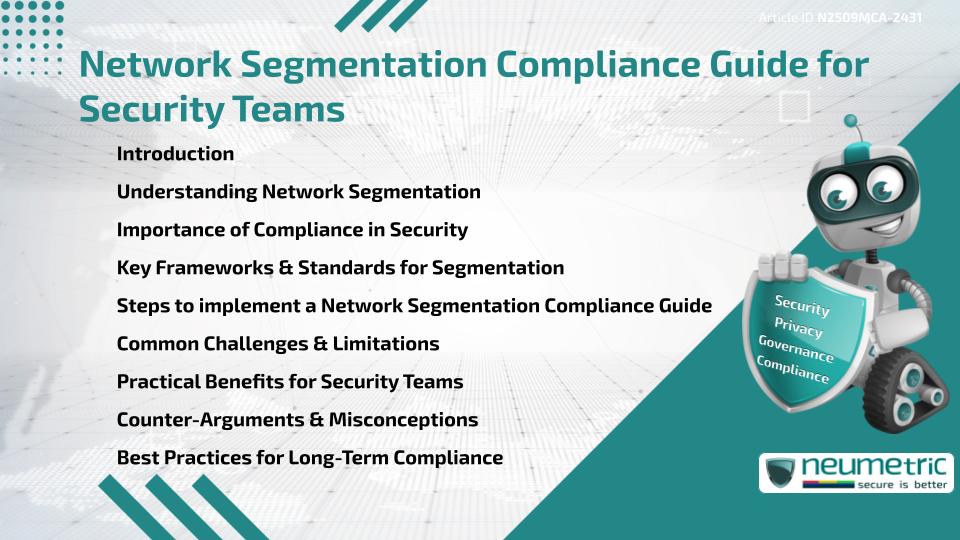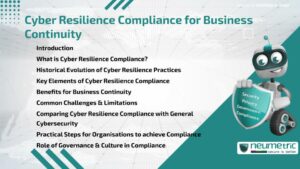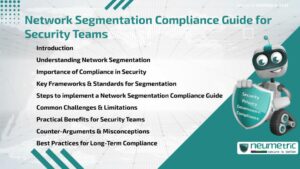Table of Contents
ToggleIntroduction
A network segmentation compliance guide is essential for modern security teams aiming to safeguard sensitive systems, meet regulatory requirements & minimise Cyber Threats. This guide provides a structured approach to dividing networks into logical zones, ensuring that access is restricted & monitored based on compliance frameworks. By following established standards, security teams can strengthen defense, simplify audits & achieve operational efficiency. From understanding Core Principles to addressing real-world challenges, this article explains everything security teams need to know about applying & maintaining compliance in network segmentation.
Understanding Network Segmentation
Network segmentation is the practice of dividing a network into isolated parts to improve control, security & performance. Think of it as creating separate rooms in a building where access is only granted to authorized individuals. In digital environments, this approach prevents attackers from moving freely if one part of the network is compromised.
Segmentation also reduces the attack surface & provides clear boundaries for monitoring traffic. For compliance purposes, it ensures that Sensitive Data is stored & transmitted only within approved network zones.
Importance of Compliance in Security
Regulatory Compliance is not just about avoiding fines but about protecting Data Integrity & Customer Trust. Many industries, such as Healthcare, Finance & retail, require strict controls over how networks are segmented. Following a network segmentation compliance guide ensures that Organisations demonstrate accountability to regulators while reducing Risks of breaches & insider misuse.
Key Frameworks & Standards for Segmentation
Several globally recognized standards outline how segmentation should be implemented:
- Payment Card Industry Data Security Standard [PCI DSS] requires isolating Cardholder Data environments.
- Health Insurance Portability & Accountability Act [HIPAA] emphasizes safeguarding Patient Data through controlled access.
- ISO 27001 provides a structured Framework for Security Controls, including segmentation.
- National Institute of Standards & Technology [NIST] SP 800-53 outlines technical & procedural safeguards for network boundaries.
These frameworks form the foundation for a robust network segmentation compliance guide.
Steps to implement a Network Segmentation Compliance Guide
- Identify sensitive assets: Classify data & systems that need heightened protection.
- Define zones: Create logical groups, such as User networks, management zones & Sensitive Data areas.
- Control access: Apply role-based Access Control so only authorized personnel can access critical segments.
- Monitor traffic: Deploy firewalls & intrusion detection systems to track activity between zones.
- Audit regularly: Ensure compliance through Continuous Monitoring & documented Evidence.
Common Challenges & Limitations
Despite its benefits, implementing segmentation can be difficult. Legacy systems may not support modern controls, making integration challenging. Excessive segmentation can also cause complexity, leading to misconfigurations or operational slowdowns. A network segmentation compliance guide should balance security needs with usability to avoid creating unnecessary obstacles for teams.
Practical Benefits for Security Teams
When properly applied, segmentation simplifies monitoring, limits the spread of malware & streamlines compliance audits. Security teams benefit from clearer visibility, reduced workload in Incident Response & improved alignment with Industry Regulations. This makes it easier to demonstrate compliance during external assessments.
Counter-Arguments & Misconceptions
Some argue that network segmentation is costly & resource-intensive. However, the long-term savings from avoided breaches & compliance penalties often outweigh initial investments. Others believe that modern cloud solutions eliminate the need for segmentation, but even in cloud environments, dividing resources into controlled zones remains critical.
Best Practices for Long-Term Compliance
- Document Policies & procedures for segmentation.
- Train staff regularly on access & monitoring responsibilities.
- Use automation tools to reduce human error.
- Review configurations after system updates or changes.
- Engage independent Auditors to validate compliance.
By following these practices, security teams can maintain consistent alignment with their network segmentation compliance guide.
Conclusion
Network segmentation is more than a technical measure; it is a compliance necessity that strengthens security across industries. By aligning segmentation strategies with recognized frameworks, security teams ensure not only legal adherence but also effective protection of organizational assets.
Takeaways
- A network segmentation compliance guide protects sensitive Systems & Data.
- Compliance frameworks like PCI DSS, HIPAA, ISO 27001 & NIST emphasize segmentation.
- Segmentation reduces Risks, simplifies audits & improves visibility.
- Balanced implementation avoids operational challenges & misconfigurations.
- Long-term compliance depends on training, monitoring & regular Audits.
FAQ
What is a network segmentation compliance guide?
It is a structured Framework that helps security teams divide networks into controlled zones to meet regulatory & security requirements.
Why is segmentation important for compliance?
Segmentation ensures Sensitive Data is protected, access is controlled & regulatory obligations are met.
Which frameworks require segmentation?
PCI DSS, HIPAA, ISO 27001 & NIST SP 800-53 all highlight segmentation as a key control.
What are the main challenges in segmentation?
Challenges include legacy system integration, misconfigurations & excessive complexity.
Does cloud computing eliminate the need for segmentation?
No, segmentation remains vital in cloud environments to control access & limit Risks.
How often should segmentation be audited?
Segmentation should be reviewed & audited regularly, especially after system changes or updates.
What are the benefits of a compliance guide for security teams?
It reduces Risks, simplifies audits, enhances monitoring & ensures regulatory alignment.
Need help for Security, Privacy, Governance & VAPT?
Neumetric provides organisations the necessary help to achieve their Cybersecurity, Compliance, Governance, Privacy, Certifications & Pentesting needs.
Organisations & Businesses, specifically those which provide SaaS & AI Solutions in the Fintech, BFSI & other regulated sectors, usually need a Cybersecurity Partner for meeting & maintaining the ongoing Security & Privacy needs & requirements of their Enterprise Clients & Privacy conscious Customers.
SOC 2, ISO 27001, ISO 42001, NIST, HIPAA, HECVAT, EU GDPR are some of the Frameworks that are served by Fusion – a SaaS, multimodular, multitenant, centralised, automated, Cybersecurity & Compliance Management system.
Neumetric also provides Expert Services for technical security which covers VAPT for Web Applications, APIs, iOS & Android Mobile Apps, Security Testing for AWS & other Cloud Environments & Cloud Infrastructure & other similar scopes.
Reach out to us by Email or filling out the Contact Form…





